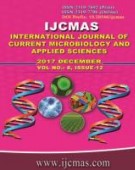


 National Academy of Agricultural Sciences (NAAS)
National Academy of Agricultural Sciences (NAAS)

|
PRINT ISSN : 2319-7692
Online ISSN : 2319-7706 Issues : 12 per year Publisher : Excellent Publishers Email : editorijcmas@gmail.com / submit@ijcmas.com Editor-in-chief: Dr.M.Prakash Index Copernicus ICV 2018: 95.39 NAAS RATING 2020: 5.38 |
The study was conducted to improve the uptake of NPK by the plants by using Biofertilizers i.e., Azatobacter chroccocum for nitrogen fixation, Psuedomonas for phosphurus solubulisation and Frauteria aurantia for potash mobilisation. Biofertlizers were collected from plant pathology lab and pure cultures were isolated. Mass cultures of the microorganisms were obtained by culturing them in their respective broth media for 10 days at 280C. Mass production of the cultures was carried out in broth. The broth was mixed well and inoculated. While transplanting seed ling dip method was used at frequent intervals of time at 30DAT, 60DAT, 90DAT. Soil samples were collected before transplanting and available NPK in soil was estimated by using standard methods described by Jackson (1967). After harvesting plant samples and soil samples were prepared for different treatments and NPK uptake was evaluated. Results revealed that Biofertilizers along with 1/2 RDF of NPK has shown better uptake of fertilizers by the plants and availability of NPK in soil on par with RDF. Lowest uptake was recorded in control followed by the treatment were only Biofertilizers were used. Thus dosage of fertilizers can be reduced to half by using biofertilizers at frequent intervals and at optimum levels which are ecofriendly and reduces cultivation cost.
 |
 |
 |
 |
 |